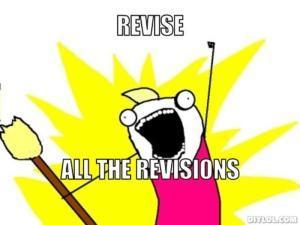Cat Hellisen's Blog, page 15
December 10, 2014
Not Your Nano day 10 – Fifteen Minutes of Fame
Some of you have read Stephen King’s On Writing, or have gone through Uncle Jim’s thread on AbsoluteWrite. Both writers talk about sitting down and either writing 2000 words and doing nothing else until they hit goal, or about sitting for 2 hours and not being allowed to do anything but write or stare blankly at the screen until those 2 hours are up.
Both techniques = amazing word count goals, and if you can be that prolific, I salute you. For me though, I homeschool during the day, run a house filled with pets, and even with the best intentions, I don’t often get a set unbroken two hours to just write without interruption. I probably could if I was willing to write at 10 pm, but gah, no thanks. My brain is dead by then.
What I can get is 15 minutes. There is *always* a way for me to shut everyone out for 15 minutes and knuckle down to some dedicated wordage. You’d be surprised at how many words you can get down in that amount of time. 15 minutes, like 100 words, is not overwhelming. (Or of it is, try for ten minutes instead.)
So, next time you settle down for your 100 words, set your phone’s timer (or go here) for fifteen minutes, open your Square Brackets of Absolution, and start typing until that buzzer goes.
If you have some friends on twitter or social media who are also slow (or fast) noveling, then set a time to take your 15 minute sprint together. (There’s something comforting about knowing others are suffering with you.) After you’ve tried it, you’ll know if it’s a technique that you can use again, or f it’s not right (write) for you. But even knowing it’s there in your toolbox can be helpful, especially when you’re feeling stuck.
SO.
Set your timers
Chant your Mantra
Open your SBA.
100 words, go.
December 8, 2014
Not Your Nano day 9 – Stationery Moves Forward
So many writers I know, even those permanently glued to their laptops, have A Thing for stationery. It’s addictive, especially when it comes to the stuff that lies outside first drafting: note-taking, idea-jotting, dreamstorming, revising with colour pens (obviously; colour pens are like little bright slices of awesome). I don’t know why it is, but sometimes when I’m stuck, getting away from the pc and taking glitter pens and a notebook and sitting in the sunshine frees up my thinking. It lets my mind travel a different path to the one dictated by a blinking cursor.
Don’t be afraid to break patterns, to try something else and see if it works. The rule is only to keep what helps you and discard what doesn’t.
I’m stuck on a short story at the moment, and doodling around with the images that kept logjamming my brain led me to a conclusion – the story is about communication. It is about tongues. Oh, so obvious, Cat. *sigh* This was a little mind-mapping free doodle, but you can sketch characters, jot down descriptions of passers-by, scenery, little snatches of half-remembered dream images. Whatever sparks in your mind and wants to be recorded for later.
Get a cheap little note book and a collection of pens and shove them in your bag. Next time you’re stuck in a waiting room, or on a slow train, or in a boring person’s house, see what your imagination comes up with.
And now, I need to go write 100 words about tongues.
Not Your Nano day 8 – Everything Can Be Fixed In Revisions
I first read those words years ago, so long ago that I don’t even remember where I read them, but they make for a pretty good mantra.
If you feel like what you’re writing is pure shite, that’s fine. First drafts are just where we get the ideas down. Pretty comes later. Everything can be fixed in revisions.*
Say it with me.
Deep breaths.
And go.
100 words.
*And if you’re saying, but no, I have NO IDEA how to fix things in revisions, then here are two books I found to be useful – one from a story-telling perspective, and the other for nuts and bolts of readable prose.
Writing The Breakout Novel workbook – Donald Maass
December 7, 2014
Not Your Nano day 6 & 7 – Stars
Sorry about yesterday, we’re currently experiencing loadshedding in South Africa, so I had no access to my website until today.
Did you get your 100 words?
I did, barely. I was so not in the mood to write, having had a sparkling wine breakfast in Kirstenbosch gardens, followed by a cidery farewell on Llandudno beach. I knew it would suck f I didn’t get my words down, (oh hai thar public failure) so I forced myself to work on just 1 scene, and managed to scrape out 174 words. So I got to give myself a star.
Yep, I totally reward myself with stars. A friend of mine has gold and silver star stickers for various goals, and sticks them on her calendar. I’m cheap, so I have a markerpen-month on my cupboard. (as you can see, I haven’t written yet today, nor have I been doing great at not spending :P)
I can’t explain why being able to reward myself with that star feels good, but it does. Do you have some kind of reward/notation system in place? How does it work for you?
December 4, 2014
Not Your Nano day 5 – Be Kind
Day 5, and a little confession.
Yesterday was hard for me. Today is probably going to be hard too. These are the times when I feel like I’m kidding myself by even pretending I can write. It’s easy for me to slump into a puddle of slimy self-loathing sprinkled with the dog urine of despair.
I refuse. I will force out my 100 words, and they can be crap as crap can be and it doesn’t matter because a) Square Brackets of Absolution, and b) Everything Can Be Fixed in Revisions.
@hellioncat suggested topic for some other day: how not to feel like a total asshole if you get sick and can't write
— Beth Wodzinski, Inc (@bethwodzinski) December 3, 2014
This is a pretty good idea too. Sometimes, we just *can’t* word, for whatever reason. Sickness, life going crazy, depression taking over. If that happens, beating yourself up isn’t going to help, but a bit of kindness might. Maybe, on those days, you should go watch a really good movie or read that book that’s sitting on your bedside table. Or go out with friends/loved ones, or have a hot bath with candles and oils. Whatever is your way of spoiling yourself. Because if you saw someone beating a mule for not being able to work, you’d call the SPCA or, I dunno, attack the person yourself. But when you beat yourself up for not being able to do stuff, that’s somehow normal and okay?
How did we get to that point?
Be kind to yourself, and get up again tomorrow and trot over your jump pole.
For those who are just jumping in now – you can work on whatever you want – a new project, a half project, a million projects, revisions etc. All we want from you is 100 words, bad or good.
100 words.
GO.
December 3, 2014
Not Your Nano Day 4 – Mind maps!
GOOOD MOAAAANING MY KITTENS OF DESPAIR
Words. Did you make them? 100 words is a nice easy goal. (I set the bar low because failure makes me hate on myself too much  How many of you find that by setting a goal of 100 words, you easily surpass it? There’s something very undaunting about 100 words. Like taking a horse over a pole when you’re training it to jump. Sure, one day that horse will be launching over gates, but we start them off stepping over a jump pole on the ground. This 100 words is your jump pole. Later, if you’re feeling more confident, you can raise the pole a little, but don’t be scared of putting your pole back to the ground. This is about consistency of writing every day, rather than trying to smash records.
How many of you find that by setting a goal of 100 words, you easily surpass it? There’s something very undaunting about 100 words. Like taking a horse over a pole when you’re training it to jump. Sure, one day that horse will be launching over gates, but we start them off stepping over a jump pole on the ground. This 100 words is your jump pole. Later, if you’re feeling more confident, you can raise the pole a little, but don’t be scared of putting your pole back to the ground. This is about consistency of writing every day, rather than trying to smash records.
So today I’m going to chat a little about my own process of outlining. It tends to move around a bit, depending on what I’m working on, but here are the basics:
I get an image of a character in a particular situation/world, and I write about them for a bit. This tends to give me a feel for the narrative voice of the story
I jot down some notes and very basic research notes – though it’s unlikely that these notes will even make it all the way to the end of the story, they do usually give me the first act at least, sometimes the second. My notes doc for the current project is about 2000 words, some of that copy-pasted research. None of it is pretty or spelled correctly hahaha.
I write as much as I can, occasionally checking my notes for guidance
I get horribly stuck and brain-dead
I mind map.
Okay so here’s the fun bit. Mind mapping is me playing around with, firstly, organising my thoughts on what I have already, and secondly, seeing what connects, and what could lead where. Also: COLOUR PENS YASSSSS.
I work on my cupboard doors with whiteboard markers, (like so; though this is an old project from before I bought my set of coloured markers *sadface*)
Now, I realise not everyone has convenient cupboard doors to draw on, or space to lay out huge sheets of paper, so for those of you who like the mind-mapping idea but want to keep it manageable, there’s a program I sometimes use called Freemind.
It’s free, and I’ve found it easy to use.
Okay, so, go write your 100 words, or if you’re stuck, go dreamstorm or mindmap or whatever it is you do to spark the creative output.
December 2, 2014
Not Your Nano Day 3 – designing bridges
I said I’d talk about outlining/planning your novel a little today but before I do, just know that outlining is different things to different people. Some people write out 150 page synopses that read more like film scripts – dialogue and general descriptions – waiting to be fleshed out, others make intricate mind maps that stretch over several metres of paper, some need a very strict framework to keep their ideas in place and on track, while others need do nothing more than jot down some notes on a scrap of paper which they will then lose.
However you work – and you can work in different ways for different projects – it is your way. There’s no *better* way for everyone, just a better way for you. The best way is one that works hand in glove with your creativity and the story you are telling right now. You’ll have to be the one that figures out what exactly that is though.
For those who know their methods, off you go on your 100 words; for those who want some pointers, here are some of the techniques I’ve encountered and which seem to help different kinds of writers.
Before you get nervous about a set structure making your novel dull and lifeless, just remember: this is not the story; this is just the skeleton, the thing that gives it shape. Story is a million things working in harmony – your plot, your characters, your narrative voice, your particular style of word-play – so don’t get worried that structure = no creativity. Also, your bones can be broken and reset, you can change the shape of your novel the moment you feel it’s not working. This is what a first draft is.
So outlining.
The most rigid forms of outlining are not necessarily going to produce rigid books (though of course, they can). The outline is simply a set of girders to build the basic shape of your model – a bridge is a bridge is a bridge is not a bridge. Not all bridges look the same, though all serve the same purpose. (To provide shelter for trolls)
and this –
and this –
and, yanno, this –
So you get the idea. People who like structure before they start writing are probably going to be happiest looking through a couple of these sites/ideas.
There’s The Snowflake Method, which builds you up from a few introductory lines to a complete outline.
Have a look through blogs and books like Story Engineering which places a lot of emphasis on the Monomyth structure.
There are others which use similar steps, like Save the Cat.
All of which are worth reading through (even if you’re a pantser) just to get a general feel about story structure.
The best things about these kinds of story structures is they take away a lot of the fear that goes into starting a novel – effectively by-passing the I don’t know what I’m doing/where this story is going! moments of panic. Even if you don’t outline to this extent, it can help to make a couple of notes on key plot points to give yourself mini goals to reach before The End.
Tomorrow I’ll show you how I more or less work, which is a slightly more free-flowing (and prone to wandering off-track).
And now, open your Square Brackets of Absolution, and begin writing (or plotting).
100 words.
December 1, 2014
Not Your Nano Day 2 – Square Brackets of Absolution
The Spawn were talking in the car the other day about writing and how hard it is, especially the beginning. As Younger Spawn says, “When you have to start you can’t think of anything, but by the end, you’ve run out of space for all your ideas.” She was talking about writing prompts for school, but I think it holds for most writing.
For me, part of it is about Fear of Suck. How can I begin something if I know it’s going to suck? What’s the point? Who am I kidding? I should give up and get a real job….and so on.
So, I have come up with a plan to get me started until the ideas start rolling, and means I don’t have to feel bad about The Suck. I call it the Square Brackets of Absolution. (SBA). They’re basically a safe space to suck and write crap until I feel confident in my writing. All I have to do is when confronted with a Blank Page of Doom, I open up a square bracket, and begin typing kak.
Like so: [I have no idea what I’m doing with this scene … It was a dark and stormy night when Jane was woken by the sound of breaking glass. Her heart was going like a thing that goes really fast and all she could see in the dark was the dim tracery of shadowed furniture. Something was out of place – a cupboard door left open,with a coat thrown over it. The coat moved….
At some point the suck is going to give way to some decent writing as your creative brain crawls out of its cave and blinks blearily into the dawn of Cool Ideas. When you’re done writing you can go back and find the spot where things change, and put in your closing square bracket. You don’t have to delete the suck, you can let it stay – you never know what ideas might be hiding in the suck that you’ll only spot come revision time. The square brackets make it easy to find these passages with a search, which will make deleting them easier later.
So if you’re ready to start writing your 100 words, open up that SBA and let the ideas roll.
Tomorrow I’m going to talk a little about outlining and mapping, and give a list of some resources that have been helpful to me and other writers with different approaches to planning.
November 30, 2014
NotYourNano Day 1 – planting your tomatoes
Happy December 1st, writer-people!
This being post one, first let me add some well-rotted manure to our soil. Everything I write here is a suggestion. There is only one rule, as such – write a minimum of 100 words. If you know what you want to write, go ahead and ignore the rest of the post – it’s just going to be there for extra guidance for those who want it.
Some of you are hopping in mid-novel, you already know what you want to do and you’re just here for the tea and cake, others want a little more input. However you work is fine – there is no one size fits all for artists – if there were, we would have software writing our novels while we sit back in our hammocks drinking pink gins.
So, to start. All you have to do today is write a few sentences about your novel. It doesn’t have to be good, or catchy, or clever – this is not to hook an agent. This is to plant the idea in your head. This is the tomato seed, the very basic starting point of what you’re going to do.
Want an example? (and as I say, this doesn’t have to be pretty, it just has to get the basic idea down, it only has to make sense to you.)
My story is about a girl who feels like she can’t compete with her older sister, and after she loses her and is forced to take her place, tries to replace her with her step daughter. She’s spent her whole life trying to be daddy’s little girl, only to realise he doesn’t care because she’s a girl. It’s inspired by Snow White, but will go completely off track because that’s me. Also, it’s all about witches and women and their power, and what is good and what is evil, and how it all depends on who is doing the story-telling.
that’s 100 words.
And now the seed is waiting.
(and as an added extra, let’s talk about the novels we’re working on as tomatoes. Walk in to any grocery store, and you will be confronted with ranks of these:
I’m not going to pretend – they look great, so red and delicious and I want them on fresh bread right now with a drizzle of olive oil and some salt and black pepper.
BUT
they are not the only tomatoes, they’re just the most popular.
Go do a google image search of heirloom tomatoes or tomato varieties, and go pick one you like. I’m not even kidding, go do it. (i did, it’s part of my self-encouragement strategy) Here’s mine, it’s an Indigo Rose:
Every time I look at my tomato and decide it’s not as good or round or red or perfect as those grocery store tomatoes, I’m going to look at what *my* tomato is supposed to look like. I will be happy that my tomato is different. Revel in my tomato’s idiosyncrasies of colour and taste and shape. *This* is the tomato* I am growing.)
*If your novel is not a tomato, that’s perfectly okay. It can be an aubergine or a cucumber or a courgette or a patty pan, as long as it’s yours.
November 26, 2014
Buy Nothing December (and a wee bit of November)
Every yeah, our Christmas gets a little more expensive, and it’s time for me to adjust my mindset. In truth, we have only one income, so living like we have 2 is kinda ridiculous.
And it’s not like I have a shortage of *stuff*. Like most homes, ours has accumulated a bunch of unused crap lying around, shoved in drawers etc. So I’ve decided that except for the 1 present I still have to buy, and except for the books for the kids presents (these are second hand anyway, because my kids go through too many books), and basic groceries, this will be a Buy Nothing Month and a Bit.
Before I buy something, I need to see if a) it’s absolutely necessary b) do I have a suitable substitute c) can I recycle something else to use?
Part of this also means we will be a lot more conscientious with our recycling. (I admit, I can get … lazy) and really think about what we’re throwing away.
It’s also a good excuse to really go through my pantry and cupboards and see what I actually have. (Cat, you do not need 3 bottles each of blue, red, and green food colouring….)














